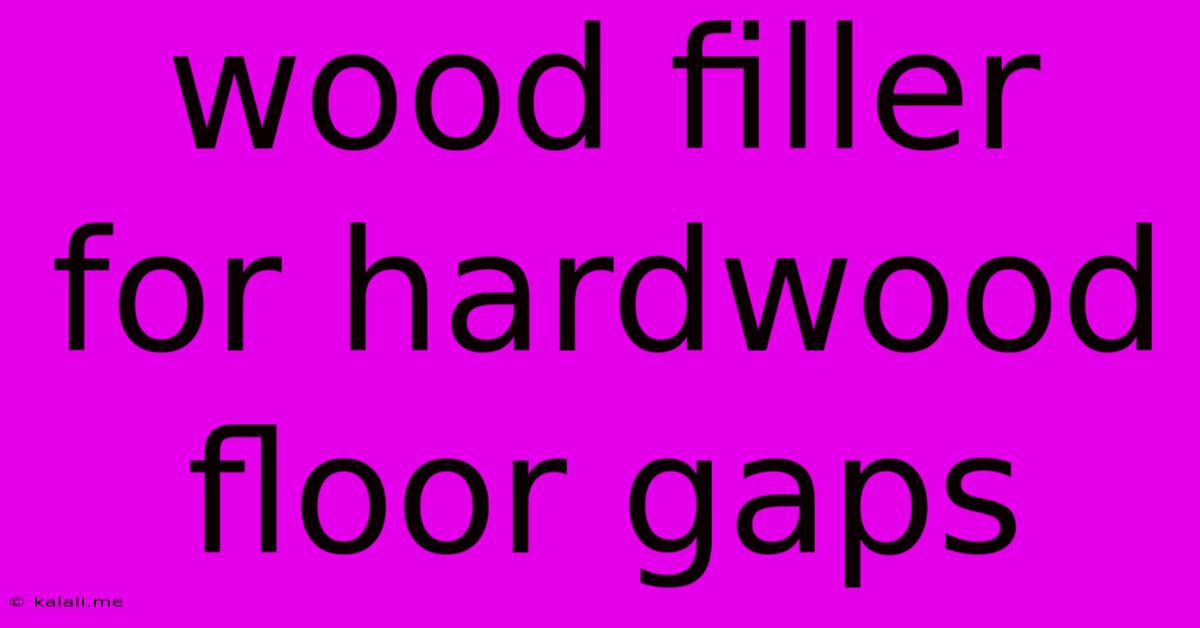Wood Filler For Hardwood Floor Gaps
Kalali
Jun 06, 2025 · 3 min read

Table of Contents
Wood Filler for Hardwood Floor Gaps: A Comprehensive Guide
Hardwood floors add warmth and elegance to any home, but over time, gaps can appear between the planks. These unsightly gaps not only detract from the aesthetic appeal but can also let in drafts and dust. Fortunately, filling these gaps is a manageable DIY project. This guide provides a comprehensive overview of using wood filler for hardwood floor gaps, covering everything from choosing the right filler to achieving a seamless finish.
Choosing the Right Wood Filler:
Selecting the appropriate wood filler is crucial for a successful repair. Consider these factors:
- Type of Wood: The color and grain of your hardwood floor will influence your filler choice. Matching the filler to your floor's color is key for an invisible repair.
- Gap Size: For smaller gaps, a standard wood filler will suffice. Larger gaps might require a two-part epoxy filler for superior strength and durability.
- Finish: Choose a filler compatible with your floor's existing finish. Oil-based fillers work well with oil-based finishes, while water-based fillers are ideal for water-based finishes. Consider using a filler specifically designed for hardwood floors to ensure compatibility.
- Drying Time: Check the drying time specified on the filler's packaging. This will influence how quickly you can proceed with sanding and finishing.
Types of Wood Filler:
Several types of wood filler cater to different needs:
- Paste Wood Filler: This is readily available and easy to apply for smaller gaps. It's generally water-based and sands smoothly.
- Putty Wood Filler: Similar to paste filler but often oil-based, providing a slightly harder finish.
- Epoxy Wood Filler: Ideal for larger gaps or areas requiring significant strength. It's a two-part system that mixes before application and cures hard.
Tools and Materials:
Before you begin, gather the necessary tools and materials:
- Wood Filler (appropriate type and color): Choose carefully based on the factors mentioned above.
- Putty Knife: For applying the filler smoothly and neatly.
- Sandpaper (various grits): Start with a coarser grit to remove excess filler, then gradually move to finer grits for a smooth finish. Consider using a sanding block for even pressure.
- Damp Rag or Sponge: To clean up excess filler.
- Vacuum Cleaner: To remove dust and debris after sanding.
- Wood Stain (optional): If the filler doesn't perfectly match your floor's color, you might need to stain it to blend seamlessly.
- Polyurethane (optional): To protect the repaired area and maintain the floor's finish.
Step-by-Step Guide to Filling Hardwood Floor Gaps:
- Prepare the Surface: Clean the gaps thoroughly to remove any dust, dirt, or debris. Use a vacuum cleaner for a thorough cleaning.
- Apply the Filler: Using a putty knife, carefully press the wood filler into the gaps, slightly overfilling them. Work in small sections for better control. Remove any excess filler immediately.
- Let it Dry: Allow the filler to dry completely according to the manufacturer's instructions. This is crucial for a successful repair.
- Sand the Filler: Once dry, use sandpaper (starting with a coarser grit) to level the filler with the surrounding wood. Sand gently to avoid damaging the surrounding planks. Gradually move to finer grits for a smoother finish.
- Clean Up: Vacuum or wipe away the sanding dust.
- Stain (Optional): If necessary, apply wood stain to match the filler to the surrounding wood. Let it dry completely.
- Apply Polyurethane (Optional): If your floor has a polyurethane finish, apply a new coat to the repaired area to protect the filler and maintain the floor's overall finish.
Tips for Success:
- Less is More: It's better to apply several thin coats of filler than one thick coat, preventing cracking and ensuring a smoother finish.
- Patience is Key: Allow ample drying time between steps. Rushing the process can lead to imperfections.
- Practice Makes Perfect: If you're unsure, practice on a less visible area before tackling prominent gaps.
By following these steps and choosing the right materials, you can successfully repair gaps in your hardwood floor, restoring its beauty and extending its lifespan. Remember, attention to detail and patience are crucial for achieving a professional-looking finish.
Latest Posts
Latest Posts
-
Lay Your Gift At The Altar
Jun 07, 2025
-
Can A New Owner Use An Old Building Permit
Jun 07, 2025
-
How To Tell If My Network Is Being Ddos
Jun 07, 2025
-
How Far From Wall Toilet Flange
Jun 07, 2025
-
How To Fix Sticky Wood Stain
Jun 07, 2025
Related Post
Thank you for visiting our website which covers about Wood Filler For Hardwood Floor Gaps . We hope the information provided has been useful to you. Feel free to contact us if you have any questions or need further assistance. See you next time and don't miss to bookmark.